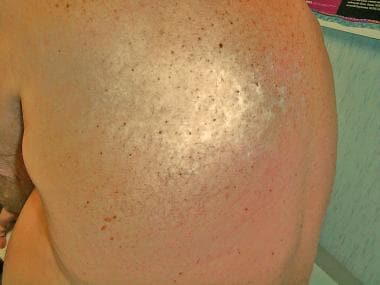Background
Herpes zoster (HZ) is a viral infection that usually presents as a childhood infection of varicella (ie, chickenpox). The pathogen is human herpesvirus (HHV)-3, also known as varicella zoster virus (VZV). Following the acute phase, the virus enters the sensory nervous system, where it is harbored in the geniculate, trigeminal, or dorsal root ganglia and remains dormant for many years. With advancing age or immunocompromised states, the virus reactivates, and an eruption (ie, shingles) occurs. Even after the acute rash subsides, pain can persist or recur in affected areas. This condition is known as postherpetic neuralgia (PHN).
A painful vesicular eruption in a dermatomal distribution is typical of HZ. (See the image below.) With resolution of the eruption, pain that continues for 3 months or more is defined as PHN. Pain is intense and may be described as burning, stabbing, or gnawing.
HZ can reactivate subclinically with pain in a dermatomal distribution without rash. [1] This condition is known as zoster sine herpete and may be more complicated, affecting multiple levels of the nervous system and causing multiple cranial neuropathies, polyneuritis, myelitis, or aseptic meningitis. [2]
No laboratory studies are usually necessary in cases of PHN. Results of cerebrospinal fluid (CSF) evaluation are abnormal in 61% of cases.
The goal of therapy for PHN is to reduce morbidity through the use of tricyclic antidepressants (TCAs), anticonvulsants, anesthetics, analgesics, corticosteroids, and antiviral agents. Vaccination is also effective for preventing HZ outbreaks and PHN. [3]
Additional concerns include cost considerations. The financial implications for treatment of PHN are becoming more important as the population ages. In a study examining annualized costs for persistent pain in patients with HZ, Dworkin et al reported that the costs were $4917 for commercially insured patients, $2696 for Medicare patients, and $9310 for Medicaid patients. [4]
Pathophysiology
Some patients with PHN appear to have abnormal function of unmyelinated nociceptors and sensory loss (usually minimal). Pain and temperature detection systems are hypersensitive to light mechanical stimulation, leading to severe pain (allodynia). Allodynia may be related to formation of new connections involving central pain transmission neurons.
Other patients with PHN may have severe, spontaneous pain without allodynia, possibly secondary to increased spontaneous activity in deafferented central neurons or reorganization of central connections. An imbalance involving loss of large inhibitory fibers and an intact or increased number of small excitatory fibers has been suggested. This input on an abnormal dorsal horn containing deafferented hypersensitive neurons supports the clinical observation that both central and peripheral areas are involved in the production of pain.
Etiology
Risk factors for the development of PHN include the following:
-
Advancing age
-
Specific sites of HZ involvement - Highest risk: trigeminal (especially ophthalmic division), brachial plexus; moderate risk: thoracic; lower risk: jaw, neck, sacral, lumbar
-
Severe prodromal pain (with HZ)
-
Severe rash
Family history has been described as a risk factor for HZ. In a case-control study of 504 patients and 523 controls, Hicks et al found that HZ patients were more likely to report blood relatives with HZ than control subjects were (39% vs 11%). This risk was higher in patients who had multiple blood relatives with HZ than in those who had only one blood relative with HZ. [5]
Epidemiology
US and international statistics
The frequency of PHN is in the range of 9-14.3% at 1 month after the onset of shingles and about 5% at 3 month. At 1 year, 3% of patients continue to have severe pain.
A study from Iceland demonstrated variations in PHN risk that were associated with different age groups. [6] No patient younger than 50 years described severe pain at any time. Patients older than 60 years described severe pain: 6% at 1 month from the onset of shingles and 4% at 3 months.
Age- and sex-related demographics
The association between age and the development of PHN is strong. [7] Advanced age appears to be the most significant risk factor for PHN. At age 60 years, approximately 60% of patients with shingles develop PHN, and at age 70 years, 75% develop PHN.
No sex predilection for PHN is known. In some studies, women have constituted the majority of patients, but this is likely to be a reflection of the usual predominance of women in older age groups.
Prognosis
PHN is not fatal. The natural history of the condition involves slow resolution of the pain syndrome. Patients may experience significant pain for a prolonged period of time.
In most patients with PHN, the pain will respond to analgesic agents (eg, TCAs). In a subgroup of patients, severe, long-lasting pain may develop that does not respond to medical therapy. Continued research for new analgesic agents is necessary.
Patient Education
For patient education resources, see the Infections Center, as well as Shingles and Chickenpox.
-
Hypopigmented rash in thoracic dermatome of postherpetic lesion.


